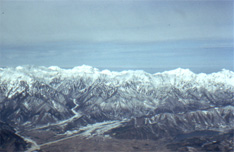| At a comfortable height above the higher mountain peaks in the area, we progress westward across the thick waist of Honshu, the largest of the islands that make up the Japanese homeland. We never stop being impressed with the percentage of square miles of this island nation that are made up of mountainous, relatively uninhabitable terrain. It is no wonder that the areas that are hospitable for human habitation are so crowded and the agricultural land so carefully planted and maintained. It is not unusual to look down at the open mouth of a volcanic mountain peak and see plumes of steam and smoke wafting upward — a reminder that the infrequent earthquake shocks we have experienced are a sign that Mother Nature in this area is in a restless mood.
While there is still good light, our scanners keep a close eye out for signs of any tell-tale leakage or smoke from the engine nacells. While we have our gauges and visual measures in the front, the scanners have a view, fortified by experience and training, that is unique to their positions. Here we see pictures of Don Kleinkauf and Ron Glowcheski at work at their positions. In the event of any mechanical failure, signs of leakage or fire, they begin a running report to the crew, giving their best assessment of the evolving situation.
In the meantime, Paul Jackson, checks out his radar scope and equipment that will permit him to track and record ship traffic and radar signals as the mission progresses into the territory of our special interests. Dick Sniker, our gunnery manager, moves freely through the aft section, pending taking his observation post in the bubble when we move into more hostile territory. Sam Farley, also enjoys the freedom of the aft section, moving into his more cramped quarters in the tail section when the time is ripe.
This is a time of relatively relaxed operation as we coast out, turn north, and progress toward our next, more critical, turn to the west and the coast of the Soviet Union. With four churning and none burning, it is a time for reflection and individual contemplation. As individuals, and as a crew, we are relatively uninformed regarding the history and specific circumstances of crews doing this work that were shot down in the months preceeding our involvement in these missions. We know that, as it relates to this “Yoke” mission, the subjects of our interest know we are coming. That is both good and bad news for us. When our blip appears on their scopes, they are not prone to press the panic button. On the other hand, they will be using their newest and best technology to see what they can learn about us and the limits of their own equipment.
During the Korean War, the mood of the Russians was more volitile, with tensions typically higher depending on day-to-day events relating to progress of the war effort. Currently there was a lot of jockeying and posturing on the part of Russians, North Korea, China, the U.S. and the U.N. It was a matter of who was facing down who today and what was the hot issue of the moment.
As we approached the northernmost turning point, it was time to make sure your bladder was emptied, the cockpit picked up, in-flight lunches eaten, and everyone ready to get down to business.
|

The rugged terrain that is Japan
|